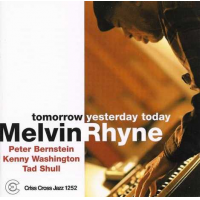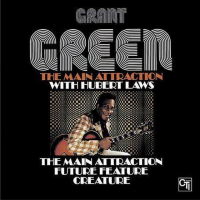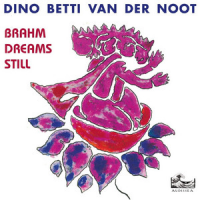Home » Jazz Articles » Liner Notes » Opus 5: Introducing Opus 5
Opus 5: Introducing Opus 5
The Evident Charms and Secret Powers of Five
For all the myriad varieties and contextual possibilities under the rubric of what makes for a valid jazz group, there is something distinctively powerful and tradition-enriched about the number five. Smaller groups tighten up the focus on individual voices involved, and often frame a specified protagonist leader, while larger groupings accentuate the greater good of the team. By contrast, the quintet format, especially in the conventional format of trumpet and tenor sax up front, with a piano-bass-drums rhythm section beneath and around the front line, can seem the ideal middle zone, with enough textural and diversity and enough close-knit intimacy to keep things lively and interesting, for musicians and listeners alike.No doubt, the power of five has become a standard bearer of jazz ensemble instrumentation, and for good reason and with solid historical roots. In effect, of course, the quintet was solidified roughly fifty years ago through the inspired auspices of Art Blakey and the Jazz Messengers and Miles Davis' great mid-'60s quintet, iconic groups which still emanate ripple effects of influence on subsequent quintets, into the indefinite future. In the cooperative group known, fittingly and philosophically, as Opus Five, the lessons and echoes of the Blakey/Miles paradigms are assuredly in place, as a model of how to operate in this mode. But sturdy traditional jazz values aside, they also bring to this model their own fresh ideas and concepts of where to take the venture, genre-wise and arrangement-wise.
While individual highs are part of the equation on this recording, the stronger collective intent is to find points of artistic collusion, to fully celebrate the "fiveness" of the situation. There may intentionally be no specified leader in the group with formidable horn players, tenor saxophonist Seamus Blake and trumpeter Alex Sipiagin at the fore, bassist Boris Kozlov and drummer Donald Edwards in the rhythm foundation, and pianist David Kikoski in the ensemble middle ground. Yet the component parts add up to an impressive and balanced whole of an ensemble personality.
New York is bustling with a wealth of robust jazz players worth hearing, who have wended their way from various global corners—this group is a kind of American-Russian-British summit meeting, a few times removed. Gatherings of players can have varying degrees of fateful collective rapport, and Opus Five is a fine example of a blessed grouping of individuals, emboldened by their connective and democratic chemistry.
One common denominator with this empathetic handful of jazz musicians is the extended legacy of Charles Mingus' dynastic, posthumous reach. Sipiagin, the Russian-born trumpet master who has lived in NYC since 1991 and has been involved with different Mingus-related projects among other connections, and he puts in stellar work on this session, on both trumpet and flugelhorn. His sympathetic alliance with the British-born NYC jazz pillar Blake, also a Mingus band regular, is evident in the easy interplay and organic looseness and eloquence of their interactions—even just the way of treating and wriggling around a melody. The Mingus connection continues with Kikoski, giving the right touch and heat to suit the tune at hand on this session, on both acoustic and electric piano, as well as longtime Mingus band rhythm players, bassist Kozlov—another Russian-in-New-York—and drummer Edwards, Louisiana-born and longtime drummer of note on the NYC jazz scene.
At times, the band's presumed conventionality disguises its sidelong maneuvers into areas of musical sophistication, not always immediately apparent in the fluid flow of the music. What sounds like an easy-does-it medium grooving introductory tunes, pianist George Cables' cool and supple composition "Think of Me," is, in fact, a tune in 9/4, but which succeeds in an easy pulse without drawing undue attention to the oddity of its meter. Cables' song, which opens with its climbing suspended chords on electric piano, is a very fine place for the quintet to start the journey of this record, as a link to jazz tradition with a musical twist subtly folded into the music's fabric.
Kikoski's original "Baker's Dozen" is a doubly-playful title in that its meter lays into an 11/8 grid, versus the 13 equation of the typical "baker's dozen." Tension and release do an intriguing dance in Kikoski's tune, as the tumbling unison bass-piano line beneath the languid, long-toned melody of the A section opens out into a more ornate, major-toned B section. The pianist himself supplies a solo interlude and a solo on the out section of the tune.
Bassist Kozlov, an inspired songsmith apart from his solidity on his instrument, supplies two strong originals to the set. "Tallysman" is a propulsive, fast neo-hard bop vehicle, whose links to the Blakey m.o. can be detected in the composition and groupthink of the track, as well as the subtle interweaving of the two horn players' parts. Easier-going, at least on the surface and basic feel, Kozlov's wittily-named "Nostalgia in Time" (a meaningful parsing of Mingus' "Nostalgia in Times Square") looks back to earlier jazz models, in hard bop and a semblance of soul-jazz resonance, with a trumpet solo of subdued, focused fire, and one of Blake's several hot, well-crafted turns of soloistic phrase heard on the date.
Throughout, Blake acquits himself beautifully, bringing his versatile strengths to bear in his engaging solo on the gentle waltz "Asami's Playland," with a sensitivity reminiscent of the saxophonist's work on John Scofield's balladic enterprise, Quiet. Elsewhere, Blake essays in an understated and poetic fashion, in stylistic synchronicity with the lingering memory of Stan Getz' Braziliana, on Toninho Horta's lovely, bittersweet-flavored bossa nova "Ton to Tom," the eloquent valentine to Horta's legendary countryman Antonio "Tom" Jobim. It's not surprising, in fact, when thing take a logical Brazilian turn on the album, under the eclectic circumstances of the session. It opens in an extra-slow and soulful mode, with the rhythm section easing into the lyrical mood, and the horn players (with Sipiagin waxing mellower on flugelhorn) take their time—and tweak the sense of time—while moving around Horta's seductively twining chord changes and searching melody line.
Just when we thought we understood the artistic parameters set forth by the group, the finale of the album sequence pulls us in seemingly opposing but ultimately symbiotic directions. The Russian folk song "Sokol," a nod in the direction of the heritage of the band's two Russian émigrés, presents the album's simplest melody, a chant-like plaint, but is set into the track which is also the longest on the record, and the one which finds the band venturing furthest into an abstract, "outside" zone.
What begins in a rhythmically open interplay of bass and drum gestures, settles into a looping melodic statement elasticized between the two horn players and set into different modes of harmonic relief by the rhythm section. A free improvisation passage, with the horn players engaging in a collective improv dialogue on a theme of controlled abandon, eases into a roiling 6/8 groove and then fast swing under Kikoski's piano solo. Edwards' impressive, motivically integrated drum solo leads back to the circular, folkloric head, finally paraphrased by Kikoski on the warm, ringing tones of his Rhodes electric piano to close.
Small surprises, generous affirmations of tradition, formidable playing and new ideas abound on this Opus Five outing. The musical evidence here syncs up with a historicist continuum, in terms of a deeply understood language and a contextual basis rearing back to early jazz quintet models of half a century hence. But, most importantly, the all-important Heat of the Moment is never forsaken: a sense of spontaneous excitement and lived-in musicality is in the offing, and in the expressive ensemble math. Five voices speak as one, and as five singular parts, in the time-honored jazz manner.
Liner Notes copyright © 2026 Josef Woodard.
Introducing Opus 5 can be purchased here.
Contact Josef Woodard at All About Jazz.
Josef Woodard is a freelance critic / journalist on the arts, with a focus on jazz. He is also a musician.
Track Listing
Think Of Me; Talltsman; Baker's Dozen; Ton To Tom; Nostalgia In Time; Asami's Playland; Sokol.
Personnel
Seamus Blake
saxophoneAlex Sipiagin
trumpetDavid Kikoski
pianoBoris Kozlov
bass, acousticDonald Edwards
drumsAlbum information
Title: Introducing Opus 5 | Year Released: 2012 | Record Label: Criss Cross
Tags
PREVIOUS / NEXT
Seamus Blake Concerts
Support All About Jazz
 All About Jazz has been a pillar of jazz since 1995, championing it as an art form and, more importantly, supporting the musicians who make it. Our enduring commitment has made "AAJ" one of the most culturally important websites of its kind, read by hundreds of thousands of fans, musicians and industry figures every month.
All About Jazz has been a pillar of jazz since 1995, championing it as an art form and, more importantly, supporting the musicians who make it. Our enduring commitment has made "AAJ" one of the most culturally important websites of its kind, read by hundreds of thousands of fans, musicians and industry figures every month.
























